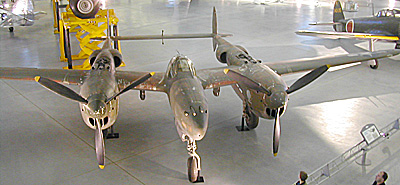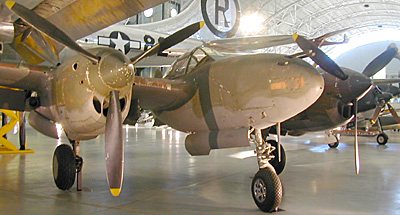 The P-38A heavy fighter had its empennage carried by two booms supporting the main units of the tricycle landing gear as well as the two engines' turbochargers. The pilot sat in the central nacelle behind heavy nose armament and nosewheel unit.
The P-38A heavy fighter had its empennage carried by two booms supporting the main units of the tricycle landing gear as well as the two engines' turbochargers. The pilot sat in the central nacelle behind heavy nose armament and nosewheel unit.
The top view of the P-38J as seen from the second floor walkway. The aircraft to the right is the Japanese N1K2 "George."
The XP-38 prototype first flew in January 1939, and considerable development paved the way for the P-38D initial operational variant (36 aircraft) that entered service in August 1941. Total production was 9393 aircraft including conversions to F-4 and F-5 reconnaissance standards. The most important fighter variants, featuring steadily more power, were the P-38E (210), P-38F (527), P-38G (1082), P-38H (601), P38J (2970) and P-38L (3923). There were also night-fighter, trainer and bomber leader conversions, and the type served successfully in every US theatre. The aircraft pictured is a P-38J.
 P-38J Lightning, dwarfed by the B-29 Enola Gay above and behind. The aircraft has been covered with a clear coat to preserve its WWII appearance.
P-38J Lightning, dwarfed by the B-29 Enola Gay above and behind. The aircraft has been covered with a clear coat to preserve its WWII appearance.
Country of origin: USA
Type: (P-38L) single-seat long-range fighter and fighter-bomber
Powerplant: two 1600hp (1193kW) Allison V-1710-111/113 (F30) 12-cylinder Vee engines
Performance: maximum speed 666km/h (414mph); climb to 6095m (20,000ft) in 7 minutes; service ceiling 13,410m (44,000ft); range 4184km (2600 miles)
Weights: empty 5806kg (12,800lb); maximum take-off 9798kg (21,600lb)
Dimensions: span 15.85m (52ft 0in); length 11.53m (37ft 10in); height 3.91m (12ft 1Oin)
Armament: one 20mm fixed forward-firing cannon and four 0.5in fixed forward-firing machine guns in the nose, plus an external bomb and rocket load of 1814kg (4000lb)
Text from: Aircraft of WWII by Chris Chant (Fiedman/Fairfax, 1999, ISBN: 1-58663-303-1), a handy book with specs for 300 aircraft.
WWI
WWII
Japan: Kawanichi N1K2-Ja Shinden Kai (George)
US: Curtiss P40 Tomahawk
Post WWII
US: Northrop N-1M Flying Wing
Other
UHC Displays
Germany: Focke-Wulf FW-190F
Germany: Arado AR-234B
Germany: Junkers JU-52/3m
Germany: Focke-Achgelis FA-330A
Germany: Rheintochter R1 Anti-aircraft Missile (Rhine Maiden)
Japan: Kawasaki Ki-45 Kai Toryu (Nick)
Japan: Aichi M6A1 Seiran
Japan: Kugisho Ohka Model 22 Cherry Blossom
US: Vought F4U Corsair
US: Lockheed P-38J Lightning
US: Boeing B-29 Superfortress "Enola Gay"
US: Grumman F6F Hellcat
US: Republic P-47D Thunderbolt
UK: DeHavilland DHC-1A Chipmunk
US: Lockheed SR-71 Blackbird
US: Space Shuttle "Enterprise"
US: Lockheed Martin X35b Joint Strike Fighter
Back to List of Historic Sites
Back to Travel Master List
Back to MagWeb Master List of Magazines
© Copyright 2004 by Coalition Web, Inc.
This article appears in MagWeb.com (Magazine Web) on the Internet World Wide Web.
Other articles covering military history and related topics are available at http://www.magweb.com